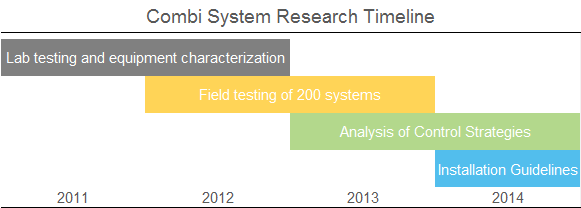Due to the energy required to heat homes going down due to better building envelopes, relative domestic hot water energy use has increased. One emerging solution to this is to integrate domestic hot water and space heating systems, which provide both heating loads with a single heating plant. These systems are called combination space and water heating systems, or “combi” systems. Despite their many benefits, these systems have a small market share because of their higher installation costs, inconsistent performance, and uncertain efficiency in a real-world setting.
Since 2011, CEE has been conducting a research project that looks at the performance of combi systems to determine their potential energy savings. The first phase of the project conducted laboratory testing to characterize the equipment and develop guidelines for installation and optimized performance. The second phase characterized the installed performance through detailed monitoring of 20 homes with combi systems and utility billing analysis of 200 systems that were installed in homes throughout Minnesota. Phase three was an analysis of several control strategies that modified the system set points and capacity to meet load. These controls have the potential to reduce energy use and simplify the installation. The fourth phase developed best practices and measure guidelines to facilitate increased installation of high performance combi systems.

Project Overview
Installation Guidelines
- Until now, the installation of each combi system required customized contractor designs, equipment selection, and commissioning to ensure the proper installation, sizing, and operation needed to achieve efficient performance. An easy to follow, simple to implement guideline based on real world experience was needed to guide program managers, utilities and installers.
- CEE developed a full measure guideline for design, installation, optimization, and verification of combi system performance.
Findings
- This research has shown that energy savings are possible with combi systems. CEE’s field studies showed about 16% natural gas savings over a traditional 80% AFUE furnace and 0.60 EF water heater. These savings are dependent on a properly installed system with lower return water temperatures (<105 °F).
- These systems are also particularly attractive in homes that are being retrofitted to reduce whole home energy consumption – such as those in low-income and utility weatherization programs. In these lower load homes, combining space and water heating loads can improve the cost effectiveness of condensing equipment.
- This project is supported by Building America, as part of the NorthernStar project team.
Related Reports and Tools